Apparatum, created by panGenerator, is a custom made apparatus with a digital interface that purely emits analogue sounds. panGenerator was inspired to build this machine because it was a reminder to the heritage of the Polish Radio Experimental Studio which was one of the very first studios in the world that produced electroacoustic music.

Boguslaw Schaeffer’s “Symphony – electronic music” along with Oskar Hansen’s “Black Room” inspired the technical pieces of the machine and the aesthetic appeal of it. In the video below it is shown that a piece of paper comes out with the audio symbols, and this was created by Schaeffer who conceived his own visual language of symbols that were cues for the sound engineer to produce.
The build of the Apparatum itself was very complex with many components including tape samplers and optical generators. What I admire about this is that the physical machine is art in itself especially with the black and white aesthetic, but with the audio features its incredible to see a machine create sound like that.

For more on the full story, click on the link below.
![[OLD FALL 2019] 15-104 • Introduction to Computing for Creative Practice](../../../../wp-content/uploads/2020/08/stop-banner.png)



